1 1). The two social determinants of health that helped
VerifiedAdded on 2023/01/16
|8
|2219
|77
AI Summary
Contribute Materials
Your contribution can guide someone’s learning journey. Share your
documents today.
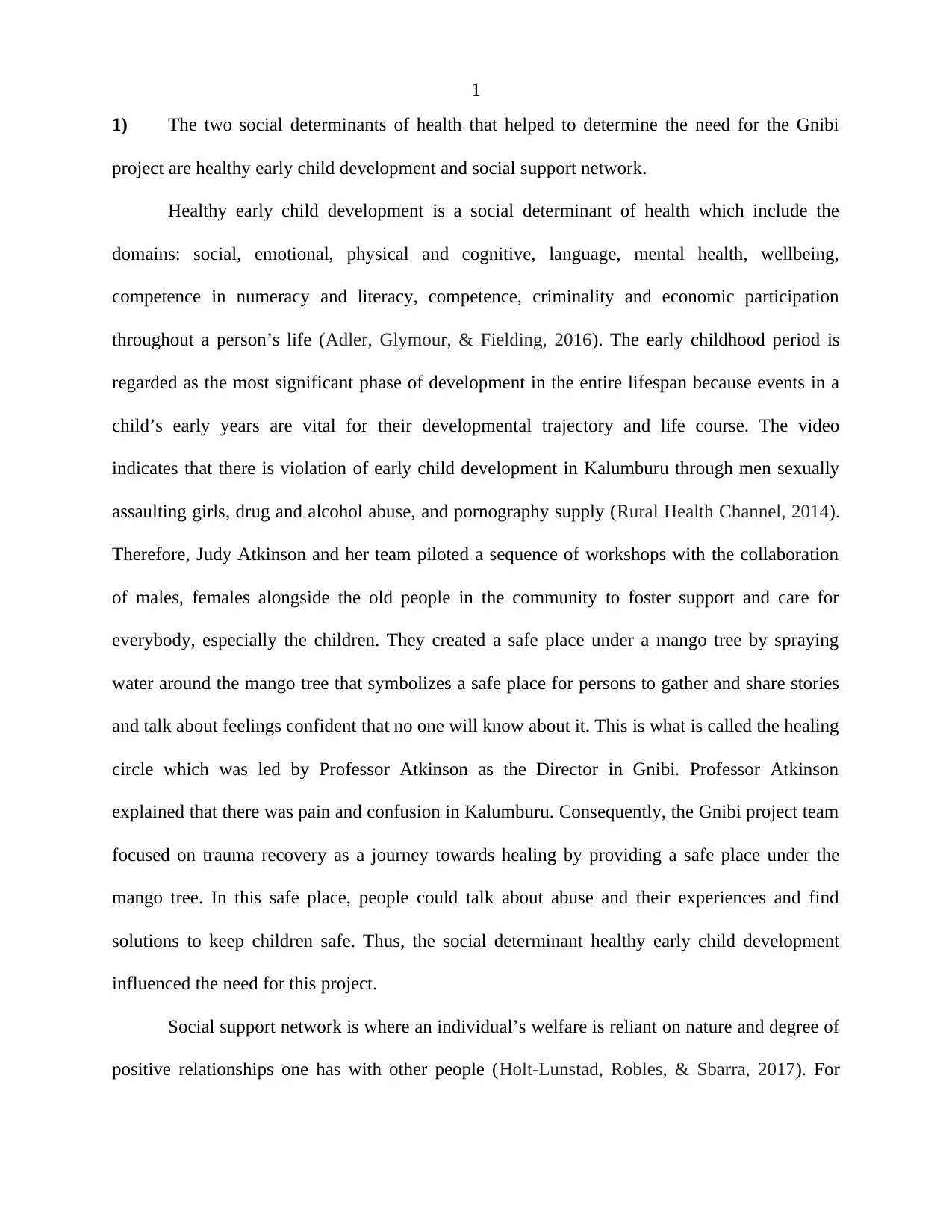
1
1) The two social determinants of health that helped to determine the need for the Gnibi
project are healthy early child development and social support network.
Healthy early child development is a social determinant of health which include the
domains: social, emotional, physical and cognitive, language, mental health, wellbeing,
competence in numeracy and literacy, competence, criminality and economic participation
throughout a person’s life (Adler, Glymour, & Fielding, 2016). The early childhood period is
regarded as the most significant phase of development in the entire lifespan because events in a
child’s early years are vital for their developmental trajectory and life course. The video
indicates that there is violation of early child development in Kalumburu through men sexually
assaulting girls, drug and alcohol abuse, and pornography supply (Rural Health Channel, 2014).
Therefore, Judy Atkinson and her team piloted a sequence of workshops with the collaboration
of males, females alongside the old people in the community to foster support and care for
everybody, especially the children. They created a safe place under a mango tree by spraying
water around the mango tree that symbolizes a safe place for persons to gather and share stories
and talk about feelings confident that no one will know about it. This is what is called the healing
circle which was led by Professor Atkinson as the Director in Gnibi. Professor Atkinson
explained that there was pain and confusion in Kalumburu. Consequently, the Gnibi project team
focused on trauma recovery as a journey towards healing by providing a safe place under the
mango tree. In this safe place, people could talk about abuse and their experiences and find
solutions to keep children safe. Thus, the social determinant healthy early child development
influenced the need for this project.
Social support network is where an individual’s welfare is reliant on nature and degree of
positive relationships one has with other people (Holt-Lunstad, Robles, & Sbarra, 2017). For
1) The two social determinants of health that helped to determine the need for the Gnibi
project are healthy early child development and social support network.
Healthy early child development is a social determinant of health which include the
domains: social, emotional, physical and cognitive, language, mental health, wellbeing,
competence in numeracy and literacy, competence, criminality and economic participation
throughout a person’s life (Adler, Glymour, & Fielding, 2016). The early childhood period is
regarded as the most significant phase of development in the entire lifespan because events in a
child’s early years are vital for their developmental trajectory and life course. The video
indicates that there is violation of early child development in Kalumburu through men sexually
assaulting girls, drug and alcohol abuse, and pornography supply (Rural Health Channel, 2014).
Therefore, Judy Atkinson and her team piloted a sequence of workshops with the collaboration
of males, females alongside the old people in the community to foster support and care for
everybody, especially the children. They created a safe place under a mango tree by spraying
water around the mango tree that symbolizes a safe place for persons to gather and share stories
and talk about feelings confident that no one will know about it. This is what is called the healing
circle which was led by Professor Atkinson as the Director in Gnibi. Professor Atkinson
explained that there was pain and confusion in Kalumburu. Consequently, the Gnibi project team
focused on trauma recovery as a journey towards healing by providing a safe place under the
mango tree. In this safe place, people could talk about abuse and their experiences and find
solutions to keep children safe. Thus, the social determinant healthy early child development
influenced the need for this project.
Social support network is where an individual’s welfare is reliant on nature and degree of
positive relationships one has with other people (Holt-Lunstad, Robles, & Sbarra, 2017). For
Secure Best Marks with AI Grader
Need help grading? Try our AI Grader for instant feedback on your assignments.
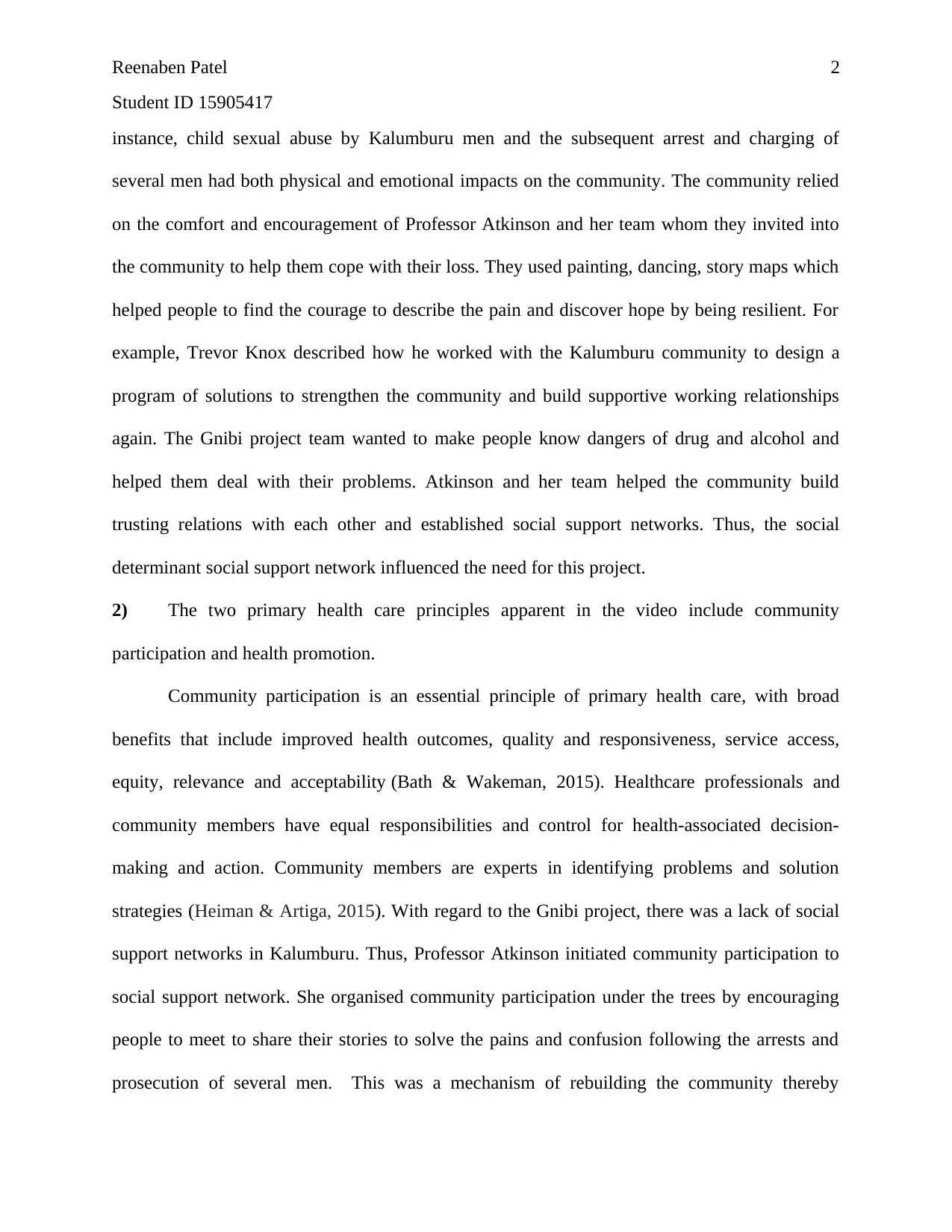
Reenaben Patel 2
Student ID 15905417
instance, child sexual abuse by Kalumburu men and the subsequent arrest and charging of
several men had both physical and emotional impacts on the community. The community relied
on the comfort and encouragement of Professor Atkinson and her team whom they invited into
the community to help them cope with their loss. They used painting, dancing, story maps which
helped people to find the courage to describe the pain and discover hope by being resilient. For
example, Trevor Knox described how he worked with the Kalumburu community to design a
program of solutions to strengthen the community and build supportive working relationships
again. The Gnibi project team wanted to make people know dangers of drug and alcohol and
helped them deal with their problems. Atkinson and her team helped the community build
trusting relations with each other and established social support networks. Thus, the social
determinant social support network influenced the need for this project.
2) The two primary health care principles apparent in the video include community
participation and health promotion.
Community participation is an essential principle of primary health care, with broad
benefits that include improved health outcomes, quality and responsiveness, service access,
equity, relevance and acceptability (Bath & Wakeman, 2015). Healthcare professionals and
community members have equal responsibilities and control for health-associated decision-
making and action. Community members are experts in identifying problems and solution
strategies (Heiman & Artiga, 2015). With regard to the Gnibi project, there was a lack of social
support networks in Kalumburu. Thus, Professor Atkinson initiated community participation to
social support network. She organised community participation under the trees by encouraging
people to meet to share their stories to solve the pains and confusion following the arrests and
prosecution of several men. This was a mechanism of rebuilding the community thereby
Student ID 15905417
instance, child sexual abuse by Kalumburu men and the subsequent arrest and charging of
several men had both physical and emotional impacts on the community. The community relied
on the comfort and encouragement of Professor Atkinson and her team whom they invited into
the community to help them cope with their loss. They used painting, dancing, story maps which
helped people to find the courage to describe the pain and discover hope by being resilient. For
example, Trevor Knox described how he worked with the Kalumburu community to design a
program of solutions to strengthen the community and build supportive working relationships
again. The Gnibi project team wanted to make people know dangers of drug and alcohol and
helped them deal with their problems. Atkinson and her team helped the community build
trusting relations with each other and established social support networks. Thus, the social
determinant social support network influenced the need for this project.
2) The two primary health care principles apparent in the video include community
participation and health promotion.
Community participation is an essential principle of primary health care, with broad
benefits that include improved health outcomes, quality and responsiveness, service access,
equity, relevance and acceptability (Bath & Wakeman, 2015). Healthcare professionals and
community members have equal responsibilities and control for health-associated decision-
making and action. Community members are experts in identifying problems and solution
strategies (Heiman & Artiga, 2015). With regard to the Gnibi project, there was a lack of social
support networks in Kalumburu. Thus, Professor Atkinson initiated community participation to
social support network. She organised community participation under the trees by encouraging
people to meet to share their stories to solve the pains and confusion following the arrests and
prosecution of several men. This was a mechanism of rebuilding the community thereby
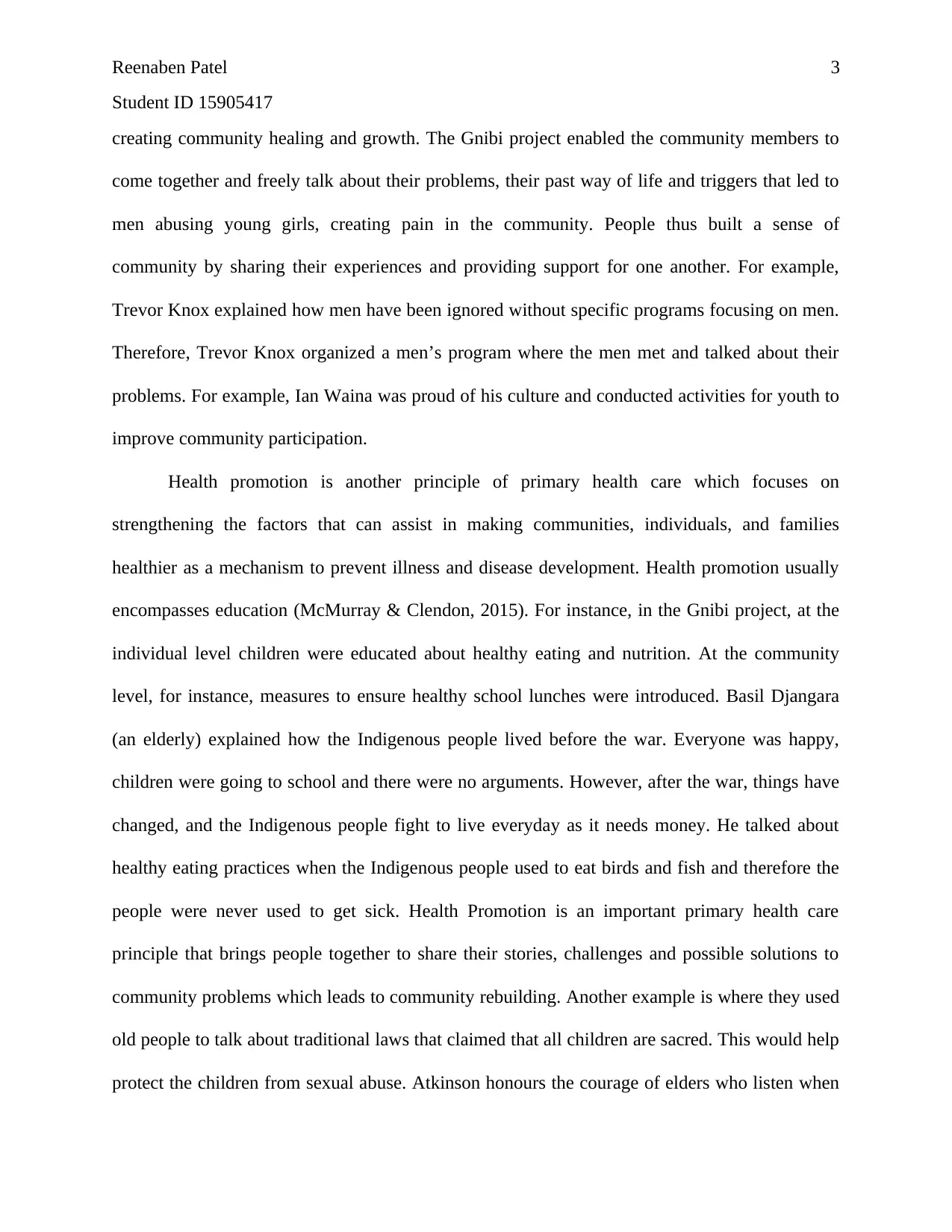
Reenaben Patel 3
Student ID 15905417
creating community healing and growth. The Gnibi project enabled the community members to
come together and freely talk about their problems, their past way of life and triggers that led to
men abusing young girls, creating pain in the community. People thus built a sense of
community by sharing their experiences and providing support for one another. For example,
Trevor Knox explained how men have been ignored without specific programs focusing on men.
Therefore, Trevor Knox organized a men’s program where the men met and talked about their
problems. For example, Ian Waina was proud of his culture and conducted activities for youth to
improve community participation.
Health promotion is another principle of primary health care which focuses on
strengthening the factors that can assist in making communities, individuals, and families
healthier as a mechanism to prevent illness and disease development. Health promotion usually
encompasses education (McMurray & Clendon, 2015). For instance, in the Gnibi project, at the
individual level children were educated about healthy eating and nutrition. At the community
level, for instance, measures to ensure healthy school lunches were introduced. Basil Djangara
(an elderly) explained how the Indigenous people lived before the war. Everyone was happy,
children were going to school and there were no arguments. However, after the war, things have
changed, and the Indigenous people fight to live everyday as it needs money. He talked about
healthy eating practices when the Indigenous people used to eat birds and fish and therefore the
people were never used to get sick. Health Promotion is an important primary health care
principle that brings people together to share their stories, challenges and possible solutions to
community problems which leads to community rebuilding. Another example is where they used
old people to talk about traditional laws that claimed that all children are sacred. This would help
protect the children from sexual abuse. Atkinson honours the courage of elders who listen when
Student ID 15905417
creating community healing and growth. The Gnibi project enabled the community members to
come together and freely talk about their problems, their past way of life and triggers that led to
men abusing young girls, creating pain in the community. People thus built a sense of
community by sharing their experiences and providing support for one another. For example,
Trevor Knox explained how men have been ignored without specific programs focusing on men.
Therefore, Trevor Knox organized a men’s program where the men met and talked about their
problems. For example, Ian Waina was proud of his culture and conducted activities for youth to
improve community participation.
Health promotion is another principle of primary health care which focuses on
strengthening the factors that can assist in making communities, individuals, and families
healthier as a mechanism to prevent illness and disease development. Health promotion usually
encompasses education (McMurray & Clendon, 2015). For instance, in the Gnibi project, at the
individual level children were educated about healthy eating and nutrition. At the community
level, for instance, measures to ensure healthy school lunches were introduced. Basil Djangara
(an elderly) explained how the Indigenous people lived before the war. Everyone was happy,
children were going to school and there were no arguments. However, after the war, things have
changed, and the Indigenous people fight to live everyday as it needs money. He talked about
healthy eating practices when the Indigenous people used to eat birds and fish and therefore the
people were never used to get sick. Health Promotion is an important primary health care
principle that brings people together to share their stories, challenges and possible solutions to
community problems which leads to community rebuilding. Another example is where they used
old people to talk about traditional laws that claimed that all children are sacred. This would help
protect the children from sexual abuse. Atkinson honours the courage of elders who listen when
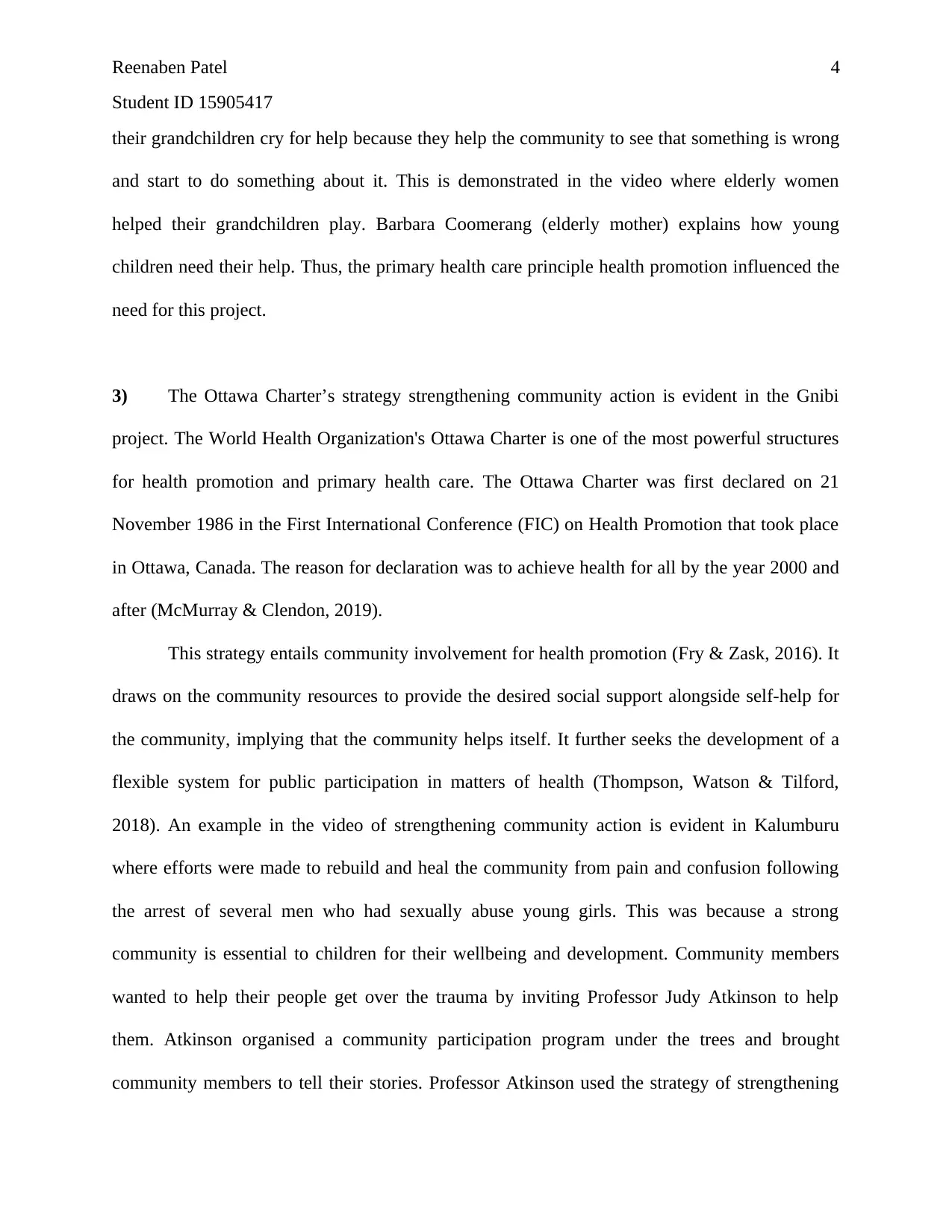
Reenaben Patel 4
Student ID 15905417
their grandchildren cry for help because they help the community to see that something is wrong
and start to do something about it. This is demonstrated in the video where elderly women
helped their grandchildren play. Barbara Coomerang (elderly mother) explains how young
children need their help. Thus, the primary health care principle health promotion influenced the
need for this project.
3) The Ottawa Charter’s strategy strengthening community action is evident in the Gnibi
project. The World Health Organization's Ottawa Charter is one of the most powerful structures
for health promotion and primary health care. The Ottawa Charter was first declared on 21
November 1986 in the First International Conference (FIC) on Health Promotion that took place
in Ottawa, Canada. The reason for declaration was to achieve health for all by the year 2000 and
after (McMurray & Clendon, 2019).
This strategy entails community involvement for health promotion (Fry & Zask, 2016). It
draws on the community resources to provide the desired social support alongside self-help for
the community, implying that the community helps itself. It further seeks the development of a
flexible system for public participation in matters of health (Thompson, Watson & Tilford,
2018). An example in the video of strengthening community action is evident in Kalumburu
where efforts were made to rebuild and heal the community from pain and confusion following
the arrest of several men who had sexually abuse young girls. This was because a strong
community is essential to children for their wellbeing and development. Community members
wanted to help their people get over the trauma by inviting Professor Judy Atkinson to help
them. Atkinson organised a community participation program under the trees and brought
community members to tell their stories. Professor Atkinson used the strategy of strengthening
Student ID 15905417
their grandchildren cry for help because they help the community to see that something is wrong
and start to do something about it. This is demonstrated in the video where elderly women
helped their grandchildren play. Barbara Coomerang (elderly mother) explains how young
children need their help. Thus, the primary health care principle health promotion influenced the
need for this project.
3) The Ottawa Charter’s strategy strengthening community action is evident in the Gnibi
project. The World Health Organization's Ottawa Charter is one of the most powerful structures
for health promotion and primary health care. The Ottawa Charter was first declared on 21
November 1986 in the First International Conference (FIC) on Health Promotion that took place
in Ottawa, Canada. The reason for declaration was to achieve health for all by the year 2000 and
after (McMurray & Clendon, 2019).
This strategy entails community involvement for health promotion (Fry & Zask, 2016). It
draws on the community resources to provide the desired social support alongside self-help for
the community, implying that the community helps itself. It further seeks the development of a
flexible system for public participation in matters of health (Thompson, Watson & Tilford,
2018). An example in the video of strengthening community action is evident in Kalumburu
where efforts were made to rebuild and heal the community from pain and confusion following
the arrest of several men who had sexually abuse young girls. This was because a strong
community is essential to children for their wellbeing and development. Community members
wanted to help their people get over the trauma by inviting Professor Judy Atkinson to help
them. Atkinson organised a community participation program under the trees and brought
community members to tell their stories. Professor Atkinson used the strategy of strengthening
Secure Best Marks with AI Grader
Need help grading? Try our AI Grader for instant feedback on your assignments.
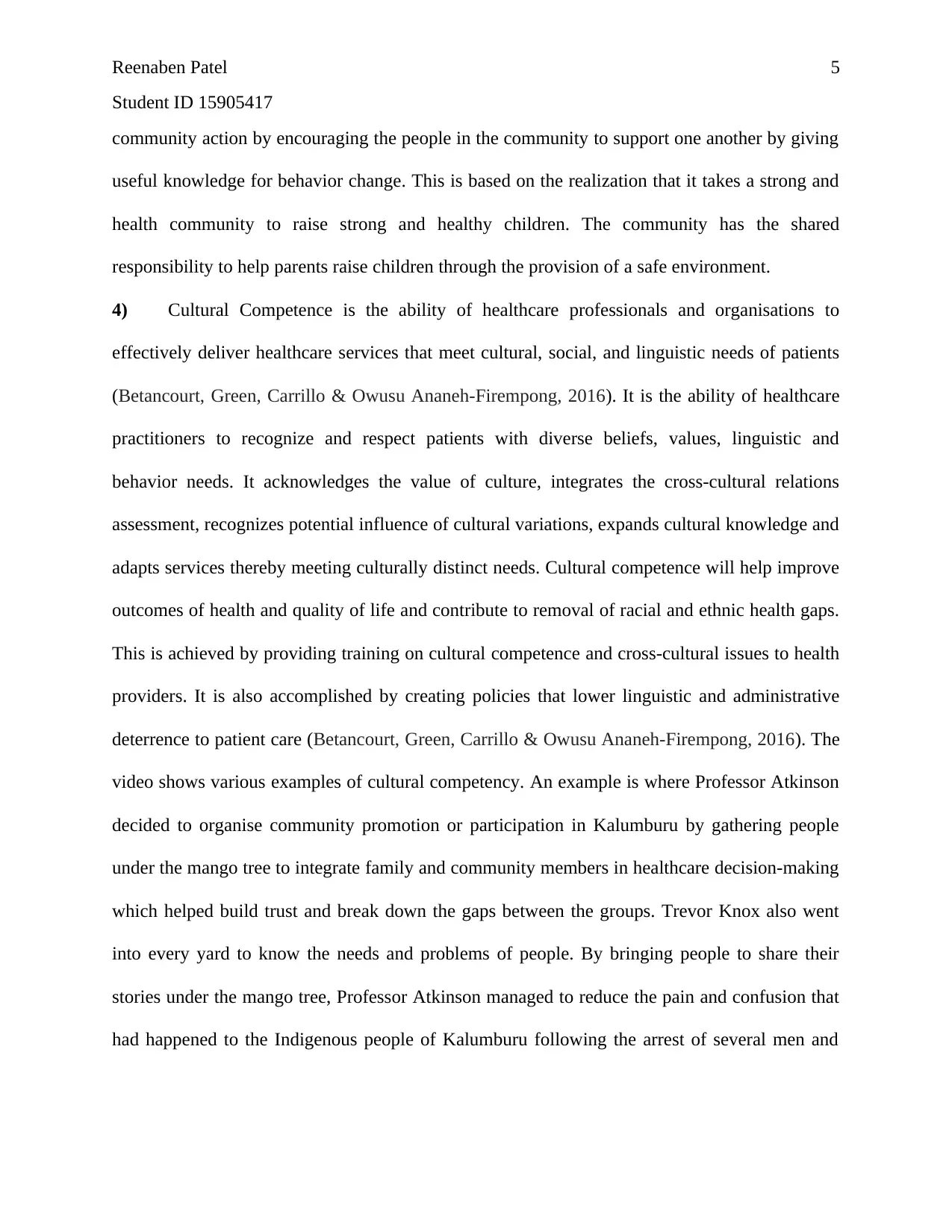
Reenaben Patel 5
Student ID 15905417
community action by encouraging the people in the community to support one another by giving
useful knowledge for behavior change. This is based on the realization that it takes a strong and
health community to raise strong and healthy children. The community has the shared
responsibility to help parents raise children through the provision of a safe environment.
4) Cultural Competence is the ability of healthcare professionals and organisations to
effectively deliver healthcare services that meet cultural, social, and linguistic needs of patients
(Betancourt, Green, Carrillo & Owusu Ananeh-Firempong, 2016). It is the ability of healthcare
practitioners to recognize and respect patients with diverse beliefs, values, linguistic and
behavior needs. It acknowledges the value of culture, integrates the cross-cultural relations
assessment, recognizes potential influence of cultural variations, expands cultural knowledge and
adapts services thereby meeting culturally distinct needs. Cultural competence will help improve
outcomes of health and quality of life and contribute to removal of racial and ethnic health gaps.
This is achieved by providing training on cultural competence and cross-cultural issues to health
providers. It is also accomplished by creating policies that lower linguistic and administrative
deterrence to patient care (Betancourt, Green, Carrillo & Owusu Ananeh-Firempong, 2016). The
video shows various examples of cultural competency. An example is where Professor Atkinson
decided to organise community promotion or participation in Kalumburu by gathering people
under the mango tree to integrate family and community members in healthcare decision-making
which helped build trust and break down the gaps between the groups. Trevor Knox also went
into every yard to know the needs and problems of people. By bringing people to share their
stories under the mango tree, Professor Atkinson managed to reduce the pain and confusion that
had happened to the Indigenous people of Kalumburu following the arrest of several men and
Student ID 15905417
community action by encouraging the people in the community to support one another by giving
useful knowledge for behavior change. This is based on the realization that it takes a strong and
health community to raise strong and healthy children. The community has the shared
responsibility to help parents raise children through the provision of a safe environment.
4) Cultural Competence is the ability of healthcare professionals and organisations to
effectively deliver healthcare services that meet cultural, social, and linguistic needs of patients
(Betancourt, Green, Carrillo & Owusu Ananeh-Firempong, 2016). It is the ability of healthcare
practitioners to recognize and respect patients with diverse beliefs, values, linguistic and
behavior needs. It acknowledges the value of culture, integrates the cross-cultural relations
assessment, recognizes potential influence of cultural variations, expands cultural knowledge and
adapts services thereby meeting culturally distinct needs. Cultural competence will help improve
outcomes of health and quality of life and contribute to removal of racial and ethnic health gaps.
This is achieved by providing training on cultural competence and cross-cultural issues to health
providers. It is also accomplished by creating policies that lower linguistic and administrative
deterrence to patient care (Betancourt, Green, Carrillo & Owusu Ananeh-Firempong, 2016). The
video shows various examples of cultural competency. An example is where Professor Atkinson
decided to organise community promotion or participation in Kalumburu by gathering people
under the mango tree to integrate family and community members in healthcare decision-making
which helped build trust and break down the gaps between the groups. Trevor Knox also went
into every yard to know the needs and problems of people. By bringing people to share their
stories under the mango tree, Professor Atkinson managed to reduce the pain and confusion that
had happened to the Indigenous people of Kalumburu following the arrest of several men and

Reenaben Patel 6
Student ID 15905417
charged for sexual assault. Therefore, cultural competence is important in determining the
success of the project.
Student ID 15905417
charged for sexual assault. Therefore, cultural competence is important in determining the
success of the project.
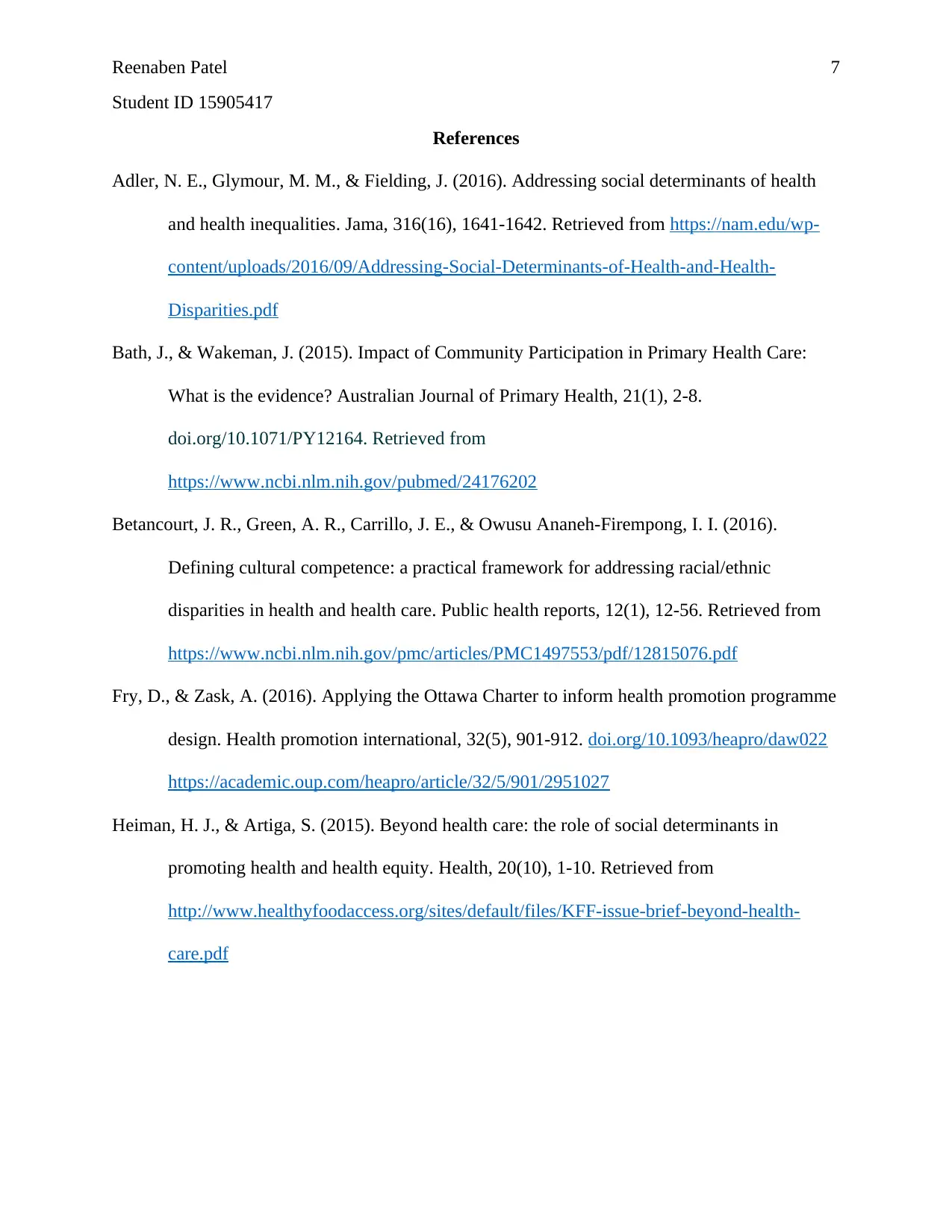
Reenaben Patel 7
Student ID 15905417
References
Adler, N. E., Glymour, M. M., & Fielding, J. (2016). Addressing social determinants of health
and health inequalities. Jama, 316(16), 1641-1642. Retrieved from https://nam.edu/wp-
content/uploads/2016/09/Addressing-Social-Determinants-of-Health-and-Health-
Disparities.pdf
Bath, J., & Wakeman, J. (2015). Impact of Community Participation in Primary Health Care:
What is the evidence? Australian Journal of Primary Health, 21(1), 2-8.
doi.org/10.1071/PY12164. Retrieved from
https://www.ncbi.nlm.nih.gov/pubmed/24176202
Betancourt, J. R., Green, A. R., Carrillo, J. E., & Owusu Ananeh-Firempong, I. I. (2016).
Defining cultural competence: a practical framework for addressing racial/ethnic
disparities in health and health care. Public health reports, 12(1), 12-56. Retrieved from
https://www.ncbi.nlm.nih.gov/pmc/articles/PMC1497553/pdf/12815076.pdf
Fry, D., & Zask, A. (2016). Applying the Ottawa Charter to inform health promotion programme
design. Health promotion international, 32(5), 901-912. doi.org/10.1093/heapro/daw022
https://academic.oup.com/heapro/article/32/5/901/2951027
Heiman, H. J., & Artiga, S. (2015). Beyond health care: the role of social determinants in
promoting health and health equity. Health, 20(10), 1-10. Retrieved from
http://www.healthyfoodaccess.org/sites/default/files/KFF-issue-brief-beyond-health-
care.pdf
Student ID 15905417
References
Adler, N. E., Glymour, M. M., & Fielding, J. (2016). Addressing social determinants of health
and health inequalities. Jama, 316(16), 1641-1642. Retrieved from https://nam.edu/wp-
content/uploads/2016/09/Addressing-Social-Determinants-of-Health-and-Health-
Disparities.pdf
Bath, J., & Wakeman, J. (2015). Impact of Community Participation in Primary Health Care:
What is the evidence? Australian Journal of Primary Health, 21(1), 2-8.
doi.org/10.1071/PY12164. Retrieved from
https://www.ncbi.nlm.nih.gov/pubmed/24176202
Betancourt, J. R., Green, A. R., Carrillo, J. E., & Owusu Ananeh-Firempong, I. I. (2016).
Defining cultural competence: a practical framework for addressing racial/ethnic
disparities in health and health care. Public health reports, 12(1), 12-56. Retrieved from
https://www.ncbi.nlm.nih.gov/pmc/articles/PMC1497553/pdf/12815076.pdf
Fry, D., & Zask, A. (2016). Applying the Ottawa Charter to inform health promotion programme
design. Health promotion international, 32(5), 901-912. doi.org/10.1093/heapro/daw022
https://academic.oup.com/heapro/article/32/5/901/2951027
Heiman, H. J., & Artiga, S. (2015). Beyond health care: the role of social determinants in
promoting health and health equity. Health, 20(10), 1-10. Retrieved from
http://www.healthyfoodaccess.org/sites/default/files/KFF-issue-brief-beyond-health-
care.pdf
Paraphrase This Document
Need a fresh take? Get an instant paraphrase of this document with our AI Paraphraser
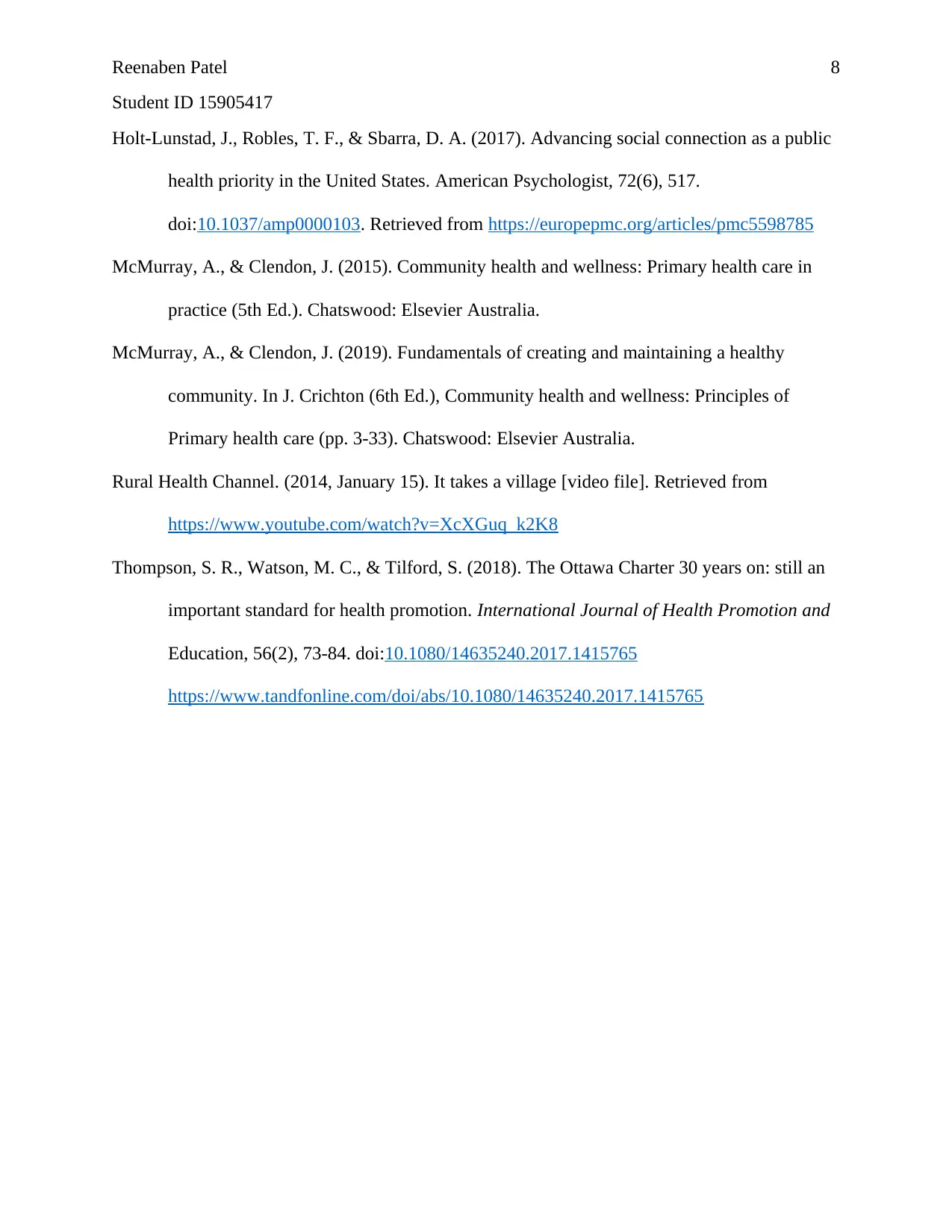
Reenaben Patel 8
Student ID 15905417
Holt-Lunstad, J., Robles, T. F., & Sbarra, D. A. (2017). Advancing social connection as a public
health priority in the United States. American Psychologist, 72(6), 517.
doi:10.1037/amp0000103. Retrieved from https://europepmc.org/articles/pmc5598785
McMurray, A., & Clendon, J. (2015). Community health and wellness: Primary health care in
practice (5th Ed.). Chatswood: Elsevier Australia.
McMurray, A., & Clendon, J. (2019). Fundamentals of creating and maintaining a healthy
community. In J. Crichton (6th Ed.), Community health and wellness: Principles of
Primary health care (pp. 3-33). Chatswood: Elsevier Australia.
Rural Health Channel. (2014, January 15). It takes a village [video file]. Retrieved from
https://www.youtube.com/watch?v=XcXGuq_k2K8
Thompson, S. R., Watson, M. C., & Tilford, S. (2018). The Ottawa Charter 30 years on: still an
important standard for health promotion. International Journal of Health Promotion and
Education, 56(2), 73-84. doi:10.1080/14635240.2017.1415765
https://www.tandfonline.com/doi/abs/10.1080/14635240.2017.1415765
Student ID 15905417
Holt-Lunstad, J., Robles, T. F., & Sbarra, D. A. (2017). Advancing social connection as a public
health priority in the United States. American Psychologist, 72(6), 517.
doi:10.1037/amp0000103. Retrieved from https://europepmc.org/articles/pmc5598785
McMurray, A., & Clendon, J. (2015). Community health and wellness: Primary health care in
practice (5th Ed.). Chatswood: Elsevier Australia.
McMurray, A., & Clendon, J. (2019). Fundamentals of creating and maintaining a healthy
community. In J. Crichton (6th Ed.), Community health and wellness: Principles of
Primary health care (pp. 3-33). Chatswood: Elsevier Australia.
Rural Health Channel. (2014, January 15). It takes a village [video file]. Retrieved from
https://www.youtube.com/watch?v=XcXGuq_k2K8
Thompson, S. R., Watson, M. C., & Tilford, S. (2018). The Ottawa Charter 30 years on: still an
important standard for health promotion. International Journal of Health Promotion and
Education, 56(2), 73-84. doi:10.1080/14635240.2017.1415765
https://www.tandfonline.com/doi/abs/10.1080/14635240.2017.1415765
1 out of 8
Related Documents
Your All-in-One AI-Powered Toolkit for Academic Success.
+13062052269
info@desklib.com
Available 24*7 on WhatsApp / Email
![[object Object]](/_next/static/media/star-bottom.7253800d.svg)
Unlock your academic potential
© 2024 | Zucol Services PVT LTD | All rights reserved.



